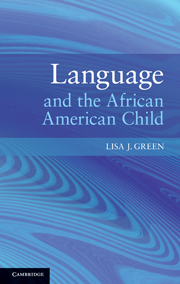Book contents
- Frontmatter
- Contents
- Figures
- Tables
- Foreword
- Preface
- Note on the text
- 1 Child AAE: an introductory overview of the data and context
- 2 Characterizing AAE: feature lists, dual components, and patterns and systems
- 3 System of tense–aspect marking 1: non-past and habitual
- 4 System of tense–aspect marking 2: past time
- 5 Negation: focus on negative concord
- 6 Asking questions: seeking clarification and requesting elaboration
- 7 Variation: intra-dialectal/variable-shifting and inter-dialectal/code-shifting
- 8 The D.I.R.E.C.T. Model: linking linguistic description and education
- Appendix A: List of participants
- Appendix B
- Notes
- References
- Index
7 - Variation: intra-dialectal/variable-shifting and inter-dialectal/code-shifting
Published online by Cambridge University Press: 05 June 2012
- Frontmatter
- Contents
- Figures
- Tables
- Foreword
- Preface
- Note on the text
- 1 Child AAE: an introductory overview of the data and context
- 2 Characterizing AAE: feature lists, dual components, and patterns and systems
- 3 System of tense–aspect marking 1: non-past and habitual
- 4 System of tense–aspect marking 2: past time
- 5 Negation: focus on negative concord
- 6 Asking questions: seeking clarification and requesting elaboration
- 7 Variation: intra-dialectal/variable-shifting and inter-dialectal/code-shifting
- 8 The D.I.R.E.C.T. Model: linking linguistic description and education
- Appendix A: List of participants
- Appendix B
- Notes
- References
- Index
Summary
LJG: If you gon be a mailman, you have to learn where everybody lives.
Dawn: I know where everybody live.
Introduction
Throughout the discussion of child AAE in this book I have tried to emphasize the importance of taking into consideration inherent variability of AAE and variation in language use in AAE speech communities in the study of patterns in the development of child AAE. It is important to understand that the linguistic variety and language use that have been the focus of the previous chapters should be considered from the angle of speech communities and to some extent networks of communication. The point is that children developing AAE as their native variety hear it consistently in their communities, so their situations are different from those who may be gaining passive knowledge of AAE and those who may have varying experiences with different speech communities and wider access to MAE. They are learning the rules of the linguistic variety, including rhetorical strategies, pragmatic contexts of particular constructions, and intonational patterns that convey particular meaning in association with certain sentence structures.
Communities of African American speakers are diverse, and the speakers’ language experiences are also diverse. Invariably, groups of African Americans who have or have had contact with AAE-speaking communities on whatever level may report that they are familiar with the types of language patterns discussed in this book, but do or did not use them for one reason or another, ranging from parental reprimand condemning the language use to parental intervention with the goal of extinguishing the stigmatized features from their children’s language and replacing them with MAE. Many of these speakers may also admit that they consider themselves capable of shifting from the variety(ies) that they may hear in the AAE-speaking communities to that which they know as part of MAE. Those who received the intervention may have been in diverse networks, and their parents may have had various linguistic experiences. Two crucial points: the first is that there is no doubt that the children from the AAE-speaking communities represented in this book will have diverse language experiences that will place them at different points on the language continuum with respect to the language use within and outside of their communities. Secondly, many of the children in the speech communities referenced here will not experience the kinds of linguistic reprimand and parental intervention as do other speakers who have more direct contact with MAE-speaking communities for the very obvious reason that they are speaking the linguistic variety that conforms to the language use of their mothers, fathers, siblings, relatives, and other persons they respect in their communities. These children are growing up with AAE as their native variety, and unlike those who received constant intervention and reprimand for using a few stigmatized features, the children in the AAE speech communities under discussion are not using a few stigmatized features periodically; they are developing a complete system of AAE and interact intimately with those who also actively use the system at home as well as outside of the home. Linguistic reprimand and parental intervention also take place in the households in these AAE speech communities, however. As it turns out, the intervention may target conventions of respect and politeness, as in the use of “politeness terms” such as “sir” and “mam” (e.g., yes sir, yes mam), and it might also target tone and other language characteristics that could be construed as expressing negative or untoward attitude, rather than a host of stigmatized grammatical patterns that are not accepted as part of MAE. It certainly is the case, however, that children may be called out for their use of ain’t.
- Type
- Chapter
- Information
- Language and the African American Child , pp. 186 - 215Publisher: Cambridge University PressPrint publication year: 2010



